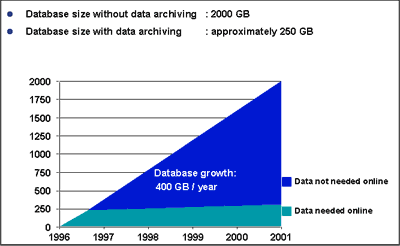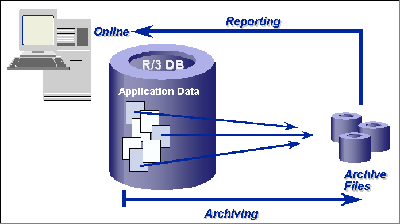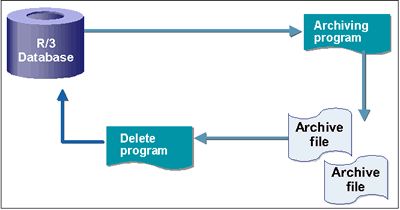|
Data Archiving
A live R/3 system will, over time, accumulate massive amounts of
data. The increasing volume of data can degrade system performance,
causing longer transaction processing times. System maintenance
tasks take longer to complete, and batch runs take longer to
process.

Does this sound familiar?
The solution to these problems is data archiving, the removal and
backup of R/3 data from the online database. Deletion of data from
the database should not be considered, as there may be legal,
regulatory, and business considerations. Some of the data may be
required at a later time to resolve customer service problems,
generate reports, or to facilitate data analysis. Therefore, the
data must be preserved in a manner that allows users to quickly
access the information if needed.
SAP Data Archiving is the only SAP-supported method for removing
data from the database consistently and maintaining the data
availability (read access) for future business requirements.
SAP data archiving:
Prevents and resolves performance problems caused by large volumes
of data (not all of the data needs to reside online)
Makes use of hardware, such as disk and memory, more efficiently
Reduce the cost of the system maintenance (for example, backup,
recovery, and upgrades)
Ensures compliance with statutory data retention rules
Ensures that data can be reused at a later date

Note: Data archiving reduces the amount of data in the
database, but does not affect the size allotment of the database
itself. Data archiving improves system performance by maintaining
system manageability.
WHEN TO START ARCHIVING
Data archiving should
be addressed during the planning stages of an R/3 implementation. It
plays an important role in maintaining the R/3 system's performance
levels. However, data archiving should not be viewed as a final
solution to prevent system downtime. Data that is nonessential for
auditing purpose should be archived as soon as possible.
Data Archiving is an interdisciplinary process, demanding high
levels of cooperation between the business user department and the
IT department. IT system administration tries to keep the database
small by deleting unnecessary data from the database. However, the
user community wants access to all documents online. To meet the
needs of both communities, the data archiving planning process must
reach a compromise.
Data archiving must be planned centrally for all departments. This
includes considerations relating to:
The required system size in relation to the anticipated data volume
(sizing)
The required residence times (the period that the data is required
online)
You should ensure that you have met all foreseeable auditing
requirements before beginning the data archiving process.
back to top
WHAT TO ARCHIVE
To identify data archival, you must know the business processes
involved. Based on the business process information, database table
growth can be analyzed and the table association to the specific
functions can be sorted. Consequently, the archive object can be
identified with the table and business information.
You must know the business processes involved before you identify
data for archival. With this knowledge, database table growth can be
analyzed to associate specific functions with the tables,
simplifying the identification of objects for archival.
Application data should not be archived until:
-
It is no longer required for processing
-
It requires no further changes
-
You are unlikely to need to display it
Before archiving application data, you must ensure that all the
required documentation has been created for subsequent auditing.
Information Retention Requirements
Information retention requirements can be divided into the following
categories:
Legal requirements: Basic accounting requirements and
specific requirements imposed by the tax authorities
Internal business requirements: Requirements imposed by
service departments, controlling or internal auditing
Technical requirements: Access times, durability of data
media, long-term readability of the information
back to top
ARCHIVING PHASES
By using SAP Data Archiving, important business objects such as
accounting documents and material master records can be selectively
removed from the database in such a way that the user does not have
to worry about the underlying physical table design. Data for
archiving is stored first in the file system, then transferred to
other storage media. For security reasons, archived data is only
deleted from the database if the previously created archive files
were read successfully.
At the very basic level, data archiving is a three-step procedure:
-
Create archiving files
-
Verify archived data and delete it from database
-
Optional, move the archived files to a storage management system
Data in the R/3 Database is archived using archiving objects that
describe the data structure and context. For example, financial
accounting documents are archived using the archiving object
FI_DOCUMNT, which includes the document header, company
code-dependent postings, change documents, SAPscript texts, and
other elements.

1. Create Archive Files
Using an archiving object, the archiving program writes the data to
be archived sequentially from the R/3 database to the archive files.
To maintain system consistency, the archiving program ensures that
only the data from completed business processed will be archived.
Master data can only be archived if it has been marked with a
deletion indicator.
2. Delete the Data
After the data to be archived has been written to archiving files,
it is removed from the database by the deletion program. For data
security reasons, the deletion program removes the data only after
the related archive files have been successfully read.
3. Storage
The created archive files can then be moved to a tertiary storage
system or copied to tape. The removal to an external storage system
can be triggered manually or automatically.
back to top
ARCHIVING ADMINISTRATION
The technical process flow of archiving generally includes three
phases:
-
Customizing
-
Execution of
Archiving
-
Management of
Archiving Files
Phase I: Customizing
General Customizing
-
Application-specific
customizing
The individual applications provide partial criteria for the
archivability or deletability of application data. These settings
are made in customizing for the relevant application. An example of
this is the setting of the residence time.
-
Customizing for SAP
ArchiveLink
Some customizing is required if the archive files are to be
transferred to a storage system over the ArchiveLink interface.
-
Platform-independent
filenames
The archive files are stored in different directories depending on
the operating system. The path and filenames therefore have a
different syntax. Consequently, platform-independent "logical"
filenames are used so that the archiving programs do not have to
handle the technical details of allocating physical names. In the
ADK runtime system, the logical filename is used to generate a
corresponding physical filename.
Object-specific Customizing
The following parameters must be set in archiving object-specific
customizing:
-
Logical filename
Select a logical filename for use by the archiving object. At
runtime, the ADK generates a physical filename from the logical
filename.
-
Archive file size
Enter the maximum size that an archive file is permitted to reach
before it is closed. You can either establish the size in MB or the
maximum number of data objects that can be written to an archive
file. Both values are queried by an OR operation. As soon as either
the maximum file size or the maximum number of data objects is
reached, the system will close the archive file and create a new
file.
-
Deletion program
settings
You can specify whether the system should execute the deletion
program automatically after an archive file has been created. Using
the Commit Counter parameter, the number of data objects required in
the deletion program before a DB commit is triggered.
Phase II:
Execution of Archiving Session
Archive
The archiving session selects the data objects from the database.
The system observes the relevant integrity conditions that
characterize a data object. It then checks each archiving object to
see whether it can be archived. If this is the case, the data object
is written to the archive file. If you have set the deletion program
to run automatically in customizing, the accompanying deletion run
starts automatically.
Delete
The deletion run must be scheduled separately if it was not executed
automatically at the archiving stage. A selection of archive files
must be made from which data objects in the current deletion run
have been read and subsequently deleted from the database.
For some archiving objects, special preprocessing and
post-processing programs prepare and clean up an archiving session,
such as post-processing programs that update statistical data after
a successful archiving session.
Phase III: Archiving management
The system does more than just write data to archive files. In
order to access the files at a later date, R/3 stores management
data on the archive files that can be displayed for any archiving
session. This includes:
-
Information on all
archive files belonging to the archiving session
-
Name, date, time and
status of the archiving session
After a certain
period of time, archived data may no longer be needed. For example,
the data may no longer need to be kept for legal or business
reasons, or the data has been transported to another format where it
remains accessible (such as print lists, microfiche or statistics
systems).
back to top
ARCHIVING OBJECTS
Database tables are not easily assigned to individual application
functions, since table contents generally originate from an
assortment of functions. To consistently archive the business data,
the archiving object, a central element of SAP Data Archiving, is
introduced.
The archiving object defines or specifies:
-
The smallest unit
that can be archived and deleted from the database
-
The application
objects to be archived
-
Which data objects
must be accessed and how to access them in order to archive a
business object fully
An archiving object
comprises three main components:
-
Write program -
Writes data objects sequentially to the archive files
-
Deletion program -
Deletes data objects from the database that have been successfully
written to an archive file
-
Preprocessing program
(optional) - Prepares the data objects for the archiving session.
Identifies the objects to be archived (sets a deletion indicator)
-
Display program
(optional): Allows archived data objects to be read
-
Post-processing
program (optional): Performs post-processing after archiving, such
as updating statistical data
-
Reload program
(optional): Loads data objects back into the database
back to top
ARCHIVING DEVELOPMENT KIT
The ADK is the central component for controlling an archiving
session. It contains functions for the analysis of individual
archiving objects and for the administration of archiving sessions.
The ADK includes the following transactions:
-
Transaction SARA for
archive administration
-
Transaction AOBJ for
the definition of archiving objects
-
Transaction ACLA for
the definition of archiving classes
-
Transaction DB15 for
monitoring the storage in the database
back to top
ACCESS ARCHIVED DATA
There are different methods to access archived data, depending on
the application area involved and the archiving object used.
-
Direct Access
The user displays archived data directly from his usual transaction.
To do this, index information on archived data must be maintained in
the database, for example, using the SAP Archiving Information
System (SAP AS). The applications must have been modified especially
for this. This method is not possible for all archiving objects.
-
SAP Archiving
Information System (SAP AS)
The SAP AS offers generic access to archived data. This access can
be enhanced using specially developed intelligent display programs.
SAP has already included such enhancements in some archiving
objects.
-
Reporting
Reporting on archived data is also possible, depending on the
application, the detail level of the result, and whether archived
data can be processed together with data from the database (mixed
reporting). In the case of a list-oriented display, the system does
not notify the user that the data selection may be incomplete, as
some data objects have already been archived.
-
Customized Access
By using the tools available in the standard system, the Archive
Development Kit (ADK) and the SAP Archive Information System (SAP
AS), it is possible to modify access to archived data in line with
specific customer requirements.
-
Document
Relationship Browser (DRB)
The SAP DRB offers generic access to archived and online data. This
access can be enhanced using specially developed intelligent display
programs. SAP has already included such enhancements in some
archiving objects
back to top
ARCHIVE INFORMATION SYSTEMS
The SAP Archive Information System is a data display and retrieval
tool that is fully integrated into the archiving environment,
assisting the user with information retrieval from R/3 data
archives.
From Release 4.5A, the SAP Archive Information System (SAP AS) is a
part of the R/3 standard functionality and can be installed on
previous releases, starting with Release 3.0D. For more information,
refer to SAPNote 99388.
Data retrieval takes place using archive information structures,
transparent database tables that contain archive data. As with other
R/3 information systems, such as the Logistics Information
Structures (LIS) or the Sales Information System (VIS), these tables
are referred to as information structures. These are composed of the
structure itself, the relevant transparent database table and an
evaluation program. When a new information structure is created,
only the structure is created in the first instance. The database
table and the evaluation program are only generated when the
information structure is activated. An archive information structure
is always assigned to an individual archiving object.
To retrieve archived data for an archiving object, at least one
archive information structure must exist. The information structure
should contain all the fields that are required for the retrieval.
The user can, if necessary, change the contents of the information
structure by removing or adding fields from an existing SAP field
catalog.
When displaying archived data, the user can usually choose between
several views (for example, technical view or business view) for
displaying data objects. A technical view is available for all
archiving objects. The availability of application views depends on
the implementation settings for the relevant archiving object. For
more information on the SAP Archiving Information System, refer to
the SAP Library under CA - Cross-Application Components ®CA -
Application Data Archiving® Introduction®Archive Information System
(SAP AS).
back to top
ARCHIVING DATA RELOAD
SAP Data Archiving allows data to be read years after it has been
archived, and across release upgrades. However, the data must be
correctly presented by the external storage system. Therefore,
reloading archived data is not generally necessary. For this reason,
reload programs are not available for all archiving objects. SAP
does not plan to support reload functions for all archiving objects.
There are two possible scenarios for the reloading of archived data:
Reloading directly after archiving
Typically, this occurs if you realize that you have archived too
much data due to incorrect selection criteria. The reload programs
are specifically designed for this situation. Therefore, reloading
usually should not cause any problems.
Reloading some time after archiving
The reloading of archived data long after the archiving is
problematic from a business point of view, since it can lead to
database inconsistencies. For instance, a number range may, in the
meantime, have become outdated and then been reissued. If you reload
old documents, more recent documents with identical numbers are
overwritten. Consequently, before reloading, you should always
discuss this with your SAP consultant.
back to top
ARCHIVING TOOLS
Archive Administration (SARA)
Archive Administration is the standard SAP tool for archiving application
data. It enables you to archive various kinds of SAP data, from
cost center (plan data) to maintenance notifications, task lists,
and posting documents.
Archive Information System (SARI)
Archive Information System (AS) is a generic standard tool delivered
by SAP that eases the customized accesses to the archived data.
back to top
top
|




